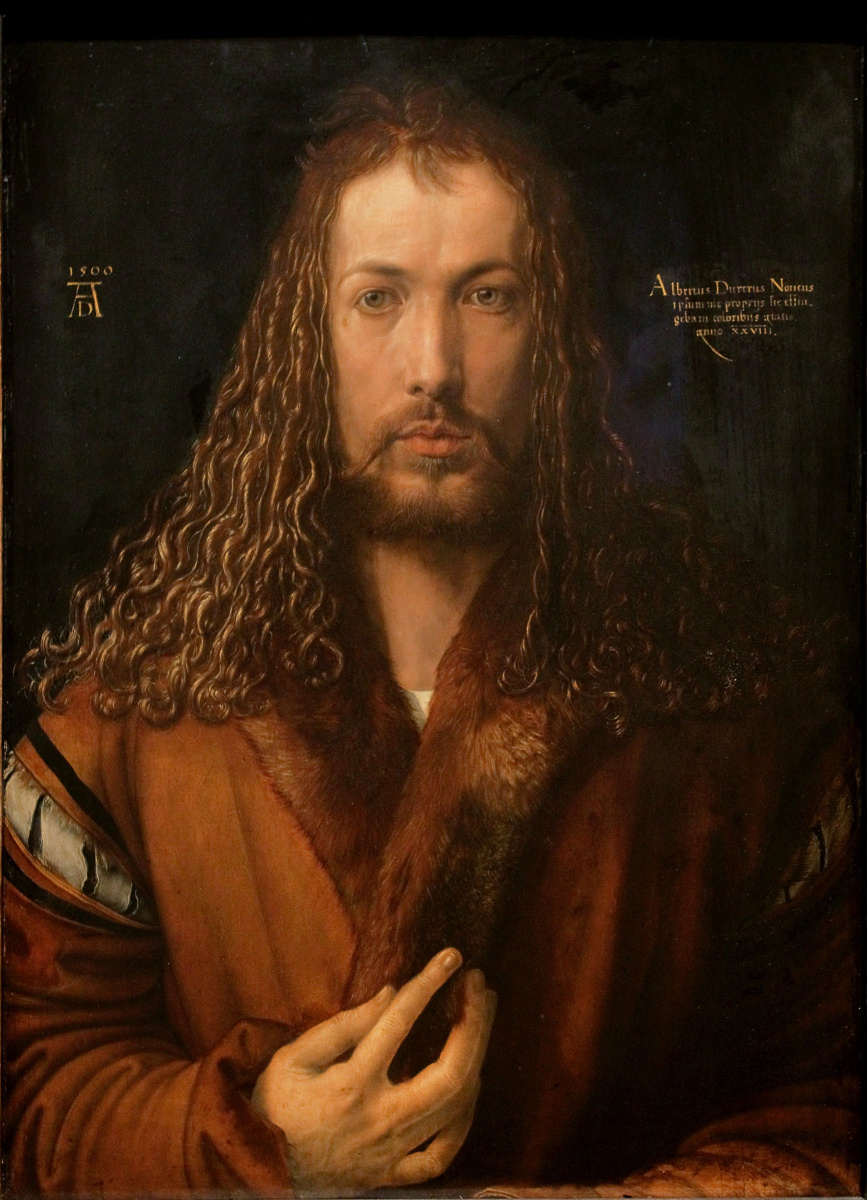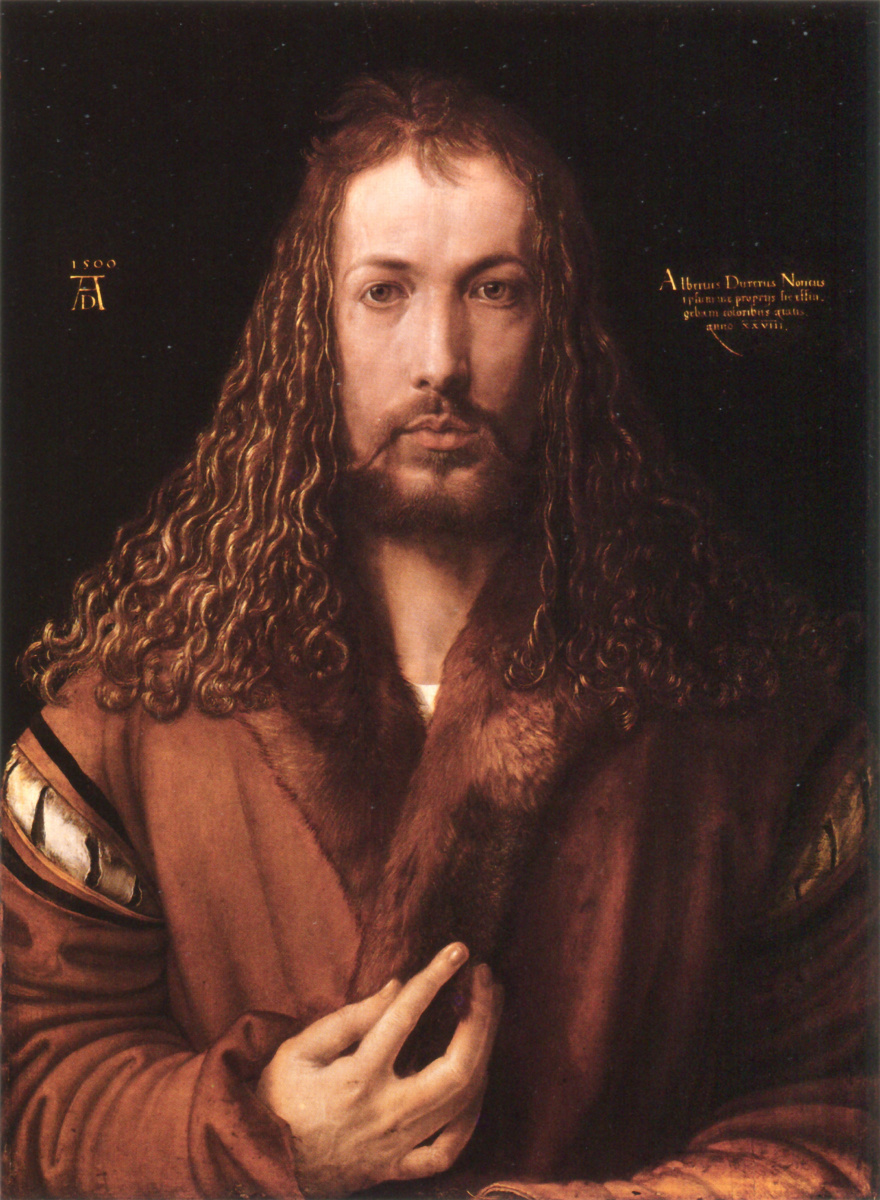log in
Enter site
Login to use Arthive functionality to the maximum
Self-portrait
Albrecht Dürer • Painting, 1500, 67×49 cm
Description of the artwork «Self-portrait»
The art critic Thomas Hoving, who was the director of the Metropolitan Museum of Art from 1967 to 1977, calls this self-portrait of Albrecht Dürer in his book The Greatest Works of Art of Western Civilization “The most arrogant, annoying, and magnificent portrait ever made.”
The third and last of the Dürer self-portraits painted in oil is kept in the Old Pinakothek of Munich, and the previous two self-portraits are in the Louvre and Prado. On first of these, the 21-year-old Dürer depicted himself in a red beret and with a thistle flower - this portrait was to best represent the appearance of the young artist to his bride, who, while Dürer wandered through Europe, his father chose him.Second self portrait depicts the 26-year-old Dürer in very expensive clothes trimmed with gold embroidery and like gloves. The new image is partly the result of his Italian journey. If the addressee of the first self-portrait was the one and only damsel agnes, who will become Dürer’s wife in a long, but unhappy and childless marriage, the addressee of the second self-portrait is the entire public (both Italian, German and all other), which claims to be versed in art. Dürer declares this to her with all his exquisite appearance: he is no longer a simple artisan - he is a master whose dignity is high and self-sufficient.
Against the background of the first two self-portraits with their very clear messages, “Self-portrait in clothes trimmed with fur” looks unexpected and mysterious. The two previous ones were made in the three-quarter spread, which was traditional for portraiture of the time, and on the third, Dürer suddenly writes himself frontally, face to face with the viewer. In the days of Dürer, it was not customary to paint secular portraits - the frontal composition was used for religious images. So, for example, portrayed Blessing Christ senior contemporary of DürerHans Memling. So what does Dürer want to say, portraying himself - frontally? What is his idea?
The art historian Marcel Brion believes that Dürer was going to write Christ from the very beginning and, for lack of a suitable model at hand, resorted to using a mirror. He seemed to hesitate during work what to write to him - the face of the Savior, which needs to be given canonically correct and at the same time individual features, or his own, already so well studied through graphic studies (1,2,3) and two oil face self-portraits.
By the year 1500, the year of the self-portrait, Dürer had achieved great success in religious art: his engravings on the theme of the Apocalypse and the Passion of Christ had pan-European popularity. He could well wish to paint the image of Christ in oil, because, experimenting in different techniques, the artist enriches and hones his skills. This person with the seal of the characteristic Dürer melancholy may well be the face of Christ, who knows about his future sufferings. This slender hand holding the clothes at the collar could be turned outward with a brush in the traditional gesture of blessing. It is noted that Dürer even gave his own nose a more refined and regular “icon-painting” shape, and made his hair brown, although in his previous portraits they are more likely to be reddish-brown - all this seems to say that Dürer’s initial design is probably not was a self portrait.
In the biographical novel of Stanislav Zarnitsky “Dürer” this moment of double perception, semantic unsteadiness of self-portrait, is well described:
- Old Durer, once having entered the workshop of his son, he saw a picture that he had just finished. Of Christ - as it seemed to the goldsmith to a master, whose vision had completely deteriorated. But, looking more closely, he saw before him not Jesus, but his Albrecht. In the portrait, his son was dressed in a rich fur coat. Her hand with pale fingers, helpless in her thinness, pulled her sides chilly. From a gloomy background, as if from non-existence, not only a face appeared - the face of a saint. An unearthly grief froze in my eyes. The inscription was written in small letters: “This is how I painted myself, Albrecht Durer from Nuremberg, at the age of 28 years with eternal colors.”
Putting this Gothic inscription on a dark background, the artist makes the final choice. “This is how I, Albrecht Dürer, portrayed myself ...“With these words he canceled all discrepancies.
Nevertheless, seekers of hidden meanings indicate that many details of the self-portrait have a dual meaning. For example, at high magnification it is seen how the reflection of the windows in the Dürer pupils form crosses. And his AD monogram next to the designation of the year 1500 can be read not as “Albrecht Dürer,” but as anno domini - i.e. from the Nativity of Christ. Martin Schave, curator of the early Germanic and Dutch painting of the Old Pinakothek, recently said in an interview with The Wall Street Journal that, in his opinion, Dürer did not paint this portrait for the public, but only for himself and, perhaps, for several artist friends - he’s so was unusual, experimental, incredible.
Was it a special impudence on the part of the artist to write himself in the image of the Savior? Yes and no. Dürer was a zealous Christian and knew that to be like Christ for a believer is not only a life task, but also a duty. The Apostle Paul taught that one needs to become like the Savior in life, - Dürer risked becoming like himself in a portrait.
Until the end of Dürer’s life, a self-portrait was always in his house. After the artist’s death, under unclear circumstances, he became the property of the Nuremberg City Hall - it is believed that this could be a gift from Dürer’s wife Agnes, and in 1805 the self-portrait was bought by the Munich Pinakothek from the City Hall.
Anna Yesterday




